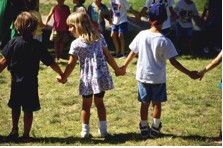Difference between revisions of "Social Communication"
| Line 18: | Line 18: | ||
===Tests to Assess Social Communication=== | ===Tests to Assess Social Communication=== | ||
====Concerns==== | ====Concerns==== | ||
| − | |||
| − | |||
| − | |||
| − | |||
| − | |||
| − | |||
| − | |||
| − | |||
| − | |||
| − | |||
| − | |||
| − | |||
| − | |||
Revision as of 16:08, 1 April 2010
Contents
Social Communication
Basic Characteristics
- Description
Social Communication is extremely impaired in people with ASD. People with ASD may display poor eye contact, difficulty understanding and using appropriate social gestures, difficulty in interpreting facial expressions, or inappropriate facial expressions. Additionally, many have poorly developed empathy and a lack of reciprocity. Often, those with ASD withdraw socially, which is largely thought to be caused by deficits in the superior temporal sulcus voice selective regions.2 However, many people with ASD express that they would like to have friends, but do not know how to make friends and retain them. Additionally, nonverbal and verbal communication is usually impaired at least slightly in those with ASD. There is large variability in language abilities in those with ASD. Some may have some language capabilities, and some may never have the ability to communicate verbally. Others may have completely normal vocabularies. Those with verbal skills could still have trouble initiating and sustaining conversations outside of their own interests. Additionally, children with autism usually have trouble understanding and integrating abstract ideas.1
Many scientists believe that genes interact with environmental triggers to create the phenotype observed in individuals. Certain genes are particularly susceptible to environmental triggers. Some scientists suggest that language development can be influenced by the presence of environmental triggers such as how many opportunities the child is given to interact with adults and learn language models.2
Potential Environmental factors can include the parents socioeconomic status, as those with higher socioeconomic status tend to talk more to their children, use a more varied vocabulary, and read bookds to their children more readily, allowing for a richness in communication experiences.5
Tests to Assess Social Communication
Concerns
References
1. Bertoglio, Kiah and Robert L. Hendren. New Developments in Autism. PMID 19248913
2. Grandgeorge, Marine et. al. Environmental Factors Influence Language Development in Children with Autism Spectrum Disorders. PLoS ONE. 2009;4(4):e4683. Epub 2009 Apr 9 PMID 19357766
3. Cotugno, A.J. Social Competence and Social Skills Training and Intervention for Children with Autism Spectrum Disorders. J Autism Dev Disord. 2009 Apr 14. PMID 19365716
4. Prendeville, J.A. et. al. Peer Play Interventions to Support the Social Competence of Children with Autism Spectrum Disorders. Semin Speech Lang. 2006 Feb;27(1):32-46 PMID 16440243
5. Grandgeorge, M. et. al. Environmental Factors Influence Language Development in Children with Autism Spectrum Disorders. PLoS ONE. 2009;4(4):e4683. Epub 2009 Apr 9. PMID 19357766
6. Tesink, CM et. al. Neural correlates of pragmatic language comprehension in autism spectrum disorders.Brain. 2009 May 7 PMID 19423680
7. Piggot, J. Neural systems approaches to the neurogenetics of autism spectrum disorders.Neuroscience. 2009 May 29 PMID 19482063
8. Hall, J. et. al.A common neural system mediating two different forms of social judgement.Psychol Med. 2009 Oct 8:1-10 PMID 19811702
9. Koegel LK. Interventions to facilitate communication in autism.J Autism Dev Disord. 2000 Oct;30(5):383-91. PMID 11098873
Related Information
- Indicators (dependent variables, conditions, or contrasts; measurement variables used for analysis) associated with this construct (vote or nominate by editing this page):
- Closely related pages (vote or nominate related pages by editing this page):
- CNP Level (What's this?)
- Cognitive Concept
External Resources
- Links out:
- Wikipedia: Joint Attention
- Google: Joint Attention
- PubMed: Joint Attention
- -ucla cognitive atlas- (coming soon!)
- Database links
